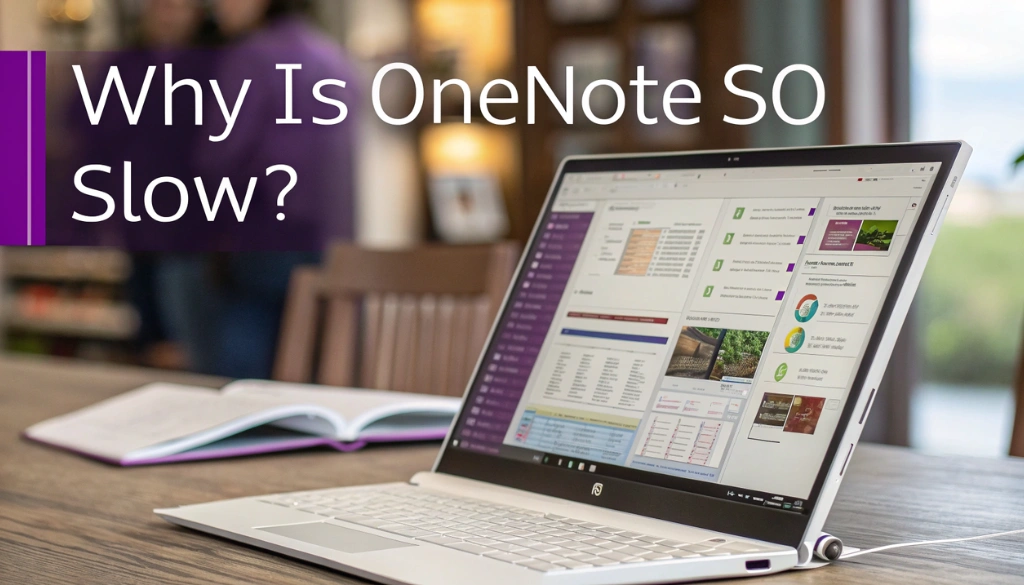Have you ever noticed that OneNote can be slow at times?
We all want our note-taking apps to work quickly and smoothly. When OneNote takes too long to load or lags while we type, it can be frustrating. This can happen for many reasons, like using too much memory or having syncing problems.
In this story, we will explore why OneNote slows down and share some easy fixes. By understanding these issues, we can improve our experience and get back to being productive with our digital notes!
Key Takeaways
- Common causes of slow OneNote performance include large notebooks, excessive syncing, and outdated software.
- Reducing the size of notebooks by archiving or deleting unnecessary sections can improve speed.
- Disabling automatic syncing or adjusting sync settings can help ease performance issues.
- Regularly updating OneNote and your device’s operating system can improve in general performance.
Identifying Common Causes of OneNote Slow Performance
Experiencing slow performance in OneNote can be frustrating. Here are common causes that may affect your user experience.
- System Resources: Low memory or high CPU usage can cause OneNote to lag. Closing unnecessary applications can remarkably increase speed.
- File Size: Large notebooks or pages filled with images can slow loading times. Testing files organized and streamlined is critical for efficiency.
- Syncing Issues: Problems with cloud storage or a weak internet connection can lead to delays. Regularly check your connection to ensure optimal performance.
- Background Processes: Other applications running in the background can drain resources. Use the task manager to identify and close resource-heavy programs.
- Updates: Running an outdated version of OneNote can introduce bugs. Always make sure you have the latest updates for improved functionality.
By identifying these factors, you can troubleshoot effectively and improve your digital note-taking experience.
Optimizing System Resources for Better Application Speed
Using OneNote can sometimes result in frustrating performance issues, such as slow loading and lag, which disrupts user experience and reduces productivity. To improve application speed, it’s critical to optimize system resources.
Here are effective strategies to increase performance:
- Manage Memory Usage: Close unnecessary applications to free up RAM and improve speed.
- Adjust CPU Usage: Set OneNote’s
Power Management Modeto “Prefer Maximum Performance” for optimal efficiency. - Disable Add-ins: Some add-ins can slow down performance. Disable them via the File menu.
- Sync Wisely: Limit auto-syncing to reduce background load, enhancing responsiveness.
By implementing these optimization techniques, you can effectively tackle performance bottlenecks and lift your OneNote experience. A well-optimized system ensures smoother note-taking and better task management!
| Optimization Technique | Benefit |
|---|---|
| Close Unused Apps | Frees up RAM |
| Adjust Power Settings | Maximizes performance |
| Disable Add-ins | Reduces lag |
| Limit Auto-sync | Less background load |
Troubleshooting Syncing Problems and Background Processes
Experiencing syncing problems in OneNote can be frustrating. Notes may load slowly or fail to sync altogether. Here are common causes and effective solutions to improve your user experience:
- Check Network Connectivity: Make sure you have a stable internet connection. A weak signal can cause significant application lag.
- Clear Cache: Corrupted cached data can disrupt syncing. Regularly clearing it can resolve these issues.
- Update OneNote: Always use the latest version. Updates often fix bugs and improve performance.
- Manage Background Processes: Running too many applications can slow down your device. Close unnecessary programs to free up system resources.
Let’s explore how these factors impact OneNote’s performance:
| Factor | Impact |
|---|---|
| Network Connectivity | Affects syncing speed |
| Cache Size | Can cause lag |
| Background Apps | Reduces available memory |
By following these steps, you can effectively resolve syncing issues and enjoy a smoother experience with OneNote!
Updating and Ensuring Compatibility for Enhanced User Experience
To improve your experience with OneNote, prioritizing updates and compatibility is critical. Performance issues like slow loading and lag often arise from outdated software or excessive memory usage.
- Check for Updates: Regular updates introduce new features and fix bugs.
- Manage Syncing: Temporarily disable auto-sync if it disrupts your workflow.
- Optimize Device Settings: Adjust power settings to improve performance.
- Clear Cache: Regularly clear the cache to free up system resources.
Understanding system requirements is critical. Older devices may struggle with OneNote’s demands. Monitoring CPU usage helps identify if other applications are causing slowdowns.
| Action | Benefit |
|---|---|
| Update OneNote | Enhances performance and fixes bugs |
| Disable Add-Ins | Reduces lag from unnecessary features |
Implementing these strategies will remarkably improve your user experience with OneNote. Let’s keep our digital note-taking smooth and efficient!
Summing up
We all want OneNote to work smoothly. When it runs slowly, it can be frustrating. By updating the app and checking our device settings, we can make it faster. Regular updates help fix bugs and improve performance. Let’s keep our OneNote running well so we can focus on our notes and ideas without any lag. Remember, a little maintenance goes a long way in enhancing our experience!

